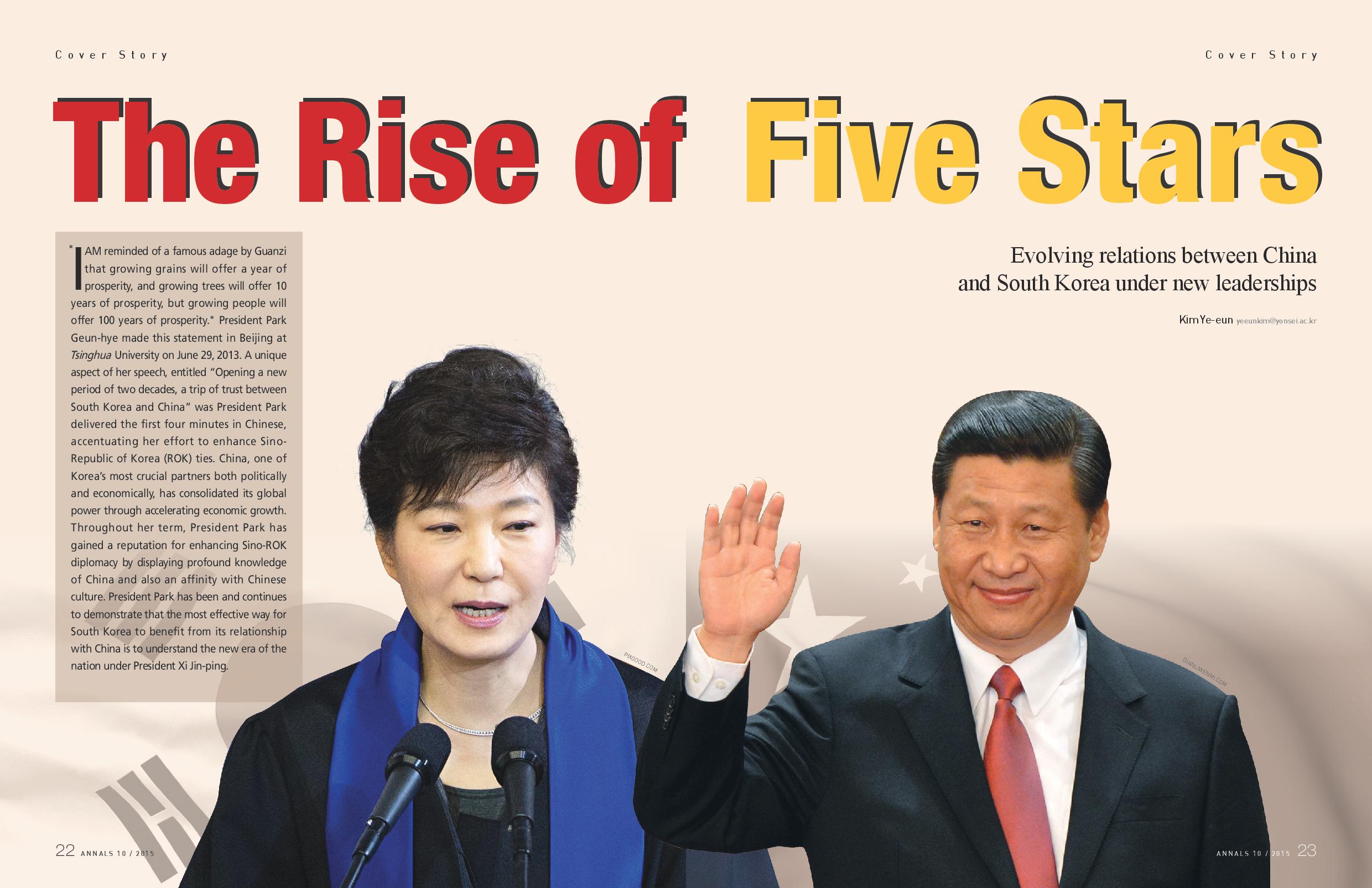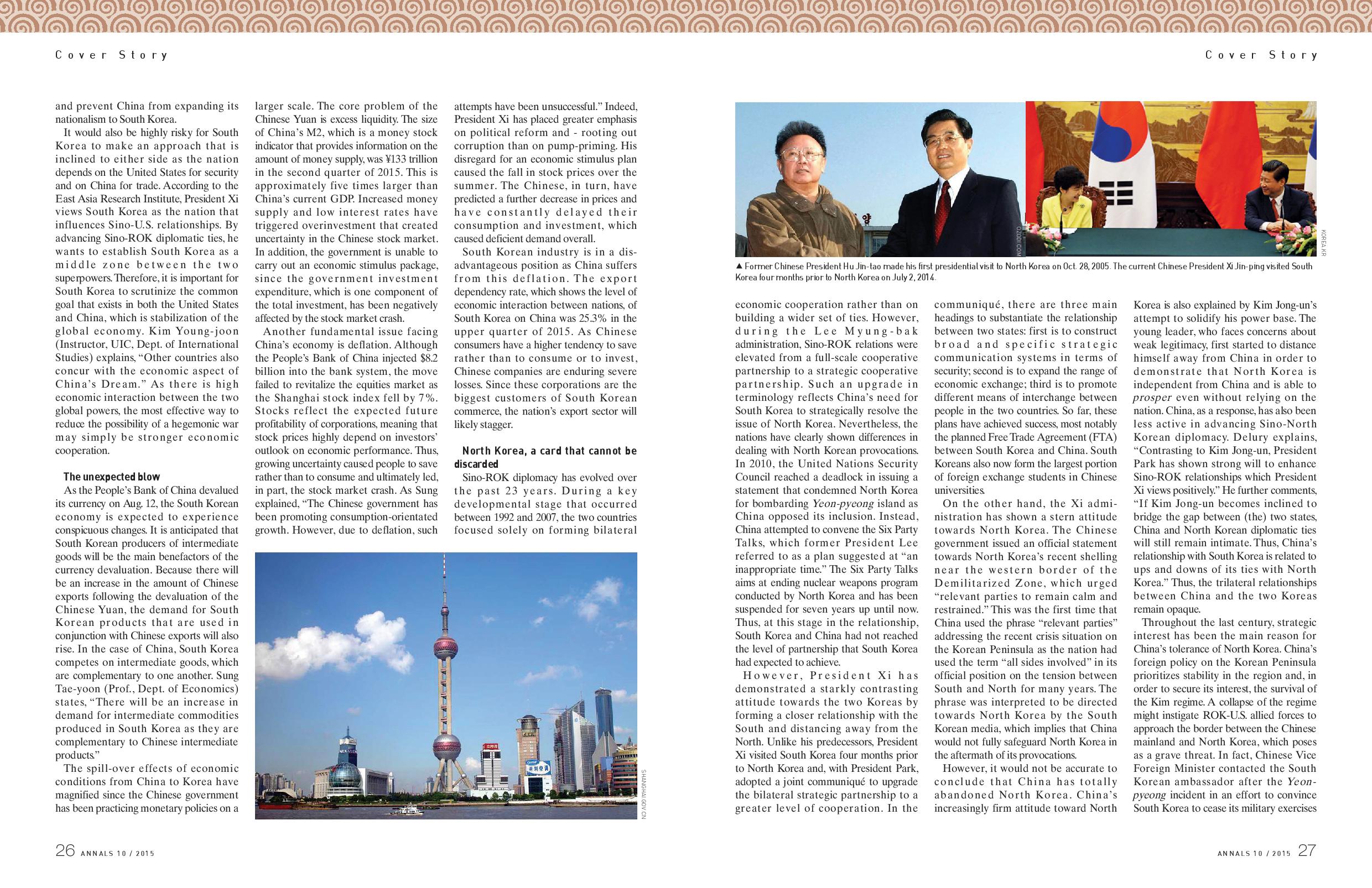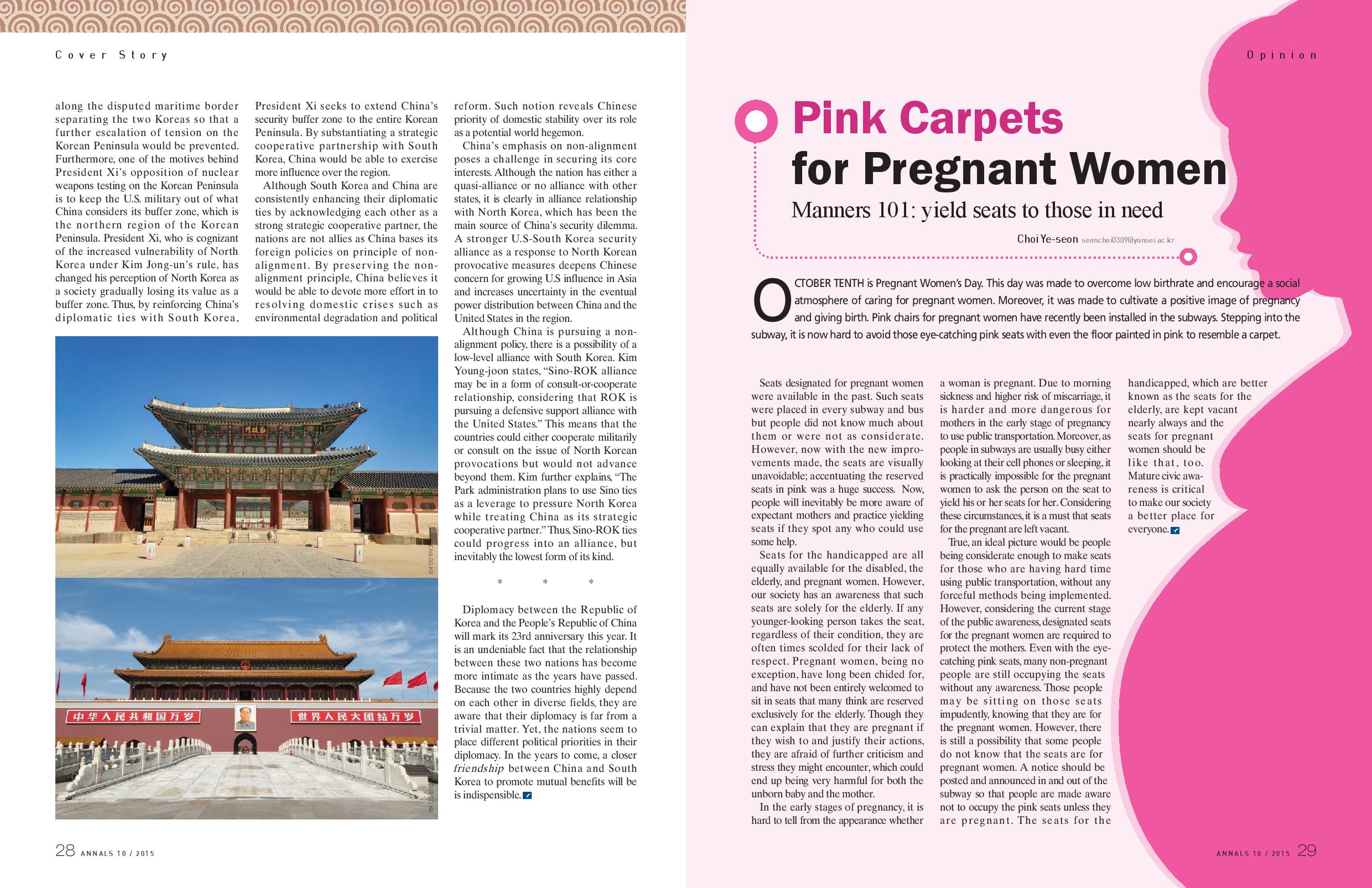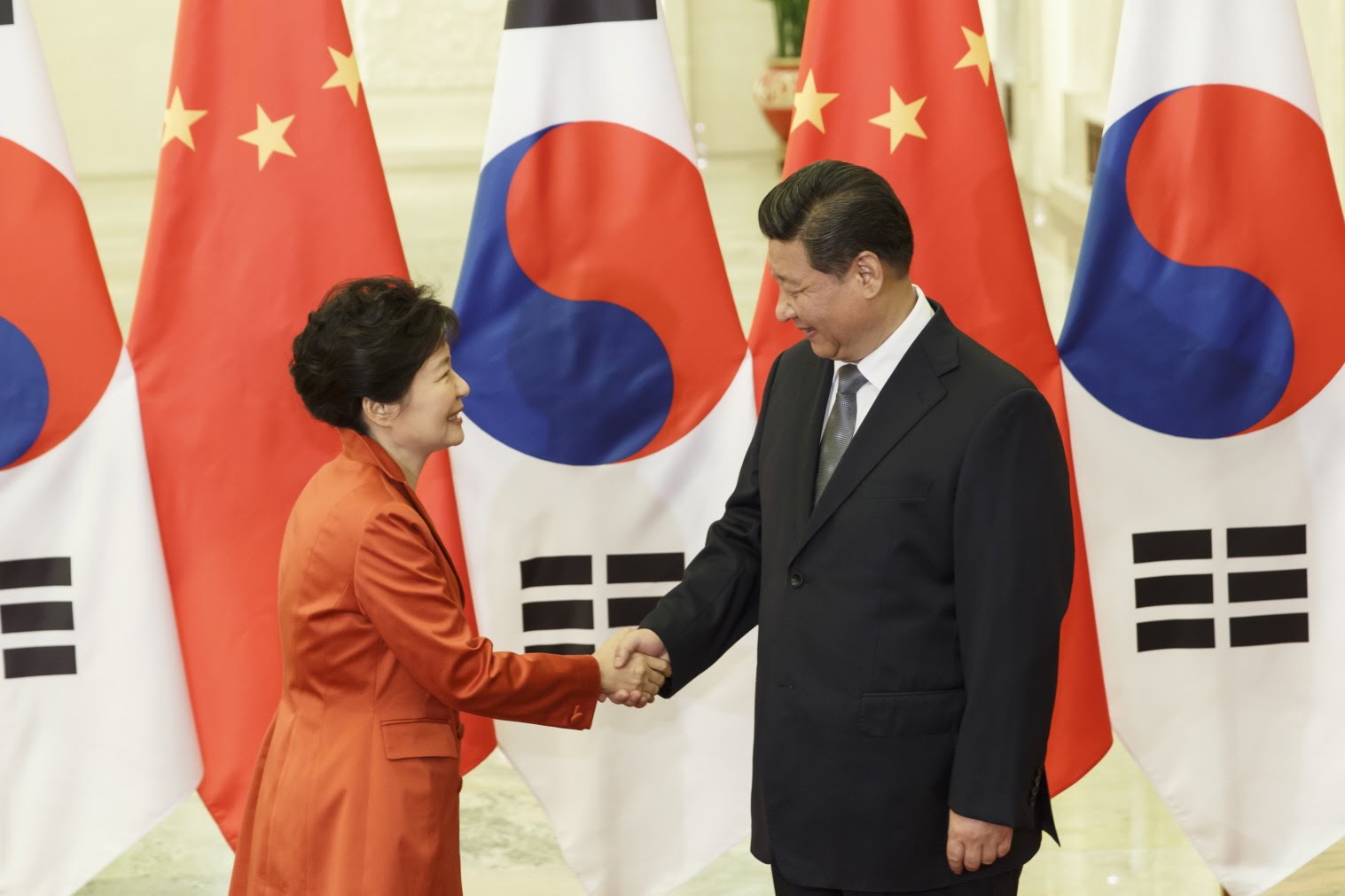Evolving relations between China and South Korea under new leaderships





“I AM reminded of a famous adage by Guanzi that growing grains will offer a year of prosperity, and growing trees will offer 10 years of prosperity, but growing people will offer 100 years of prosperity.” President Park Geun-hye made this statement in Beijing at Tsinghua University on June 29, 2013. A unique aspect of her speech, entitled “Opening a new period of two decades, a trip of trust between South Korea and China” was President Park delivered the first four minutes in Chinese, accentuating her effort to enhance Sino-Republic of Korea (ROK) ties. China, one of Korea’s most crucial partners both politically and economically, has consolidated its global power through accelerating economic growth. Throughout her term, President Park has gained a reputation for enhancing Sino-ROK diplomacy by displaying profound knowledge of China and also an affinity with Chinese culture. President Park has been and continues to demonstrate that the most effective way for South Korea to benefit from its relationship with China is to understand the new era of the nation under President Xi Jin-ping.
China’s Dream might not be Korea’s Dream
President Xi’s political slogan, the so-called Chinese Dream, forms an integral part of China today. President Xi’s tenure is to be completed in 2021, which is also the 100th anniversary of the founding of the Chinese Communist Party. With an eye toward concluding his term with a fruitful outcomes, President Xi has combined his objectives into a single slogan- China’s Dream. By emphasizing that “everyone has opportunities” and that “the policies would favor those who put in much effort,” he claims that the nation’s ultimate goal is to accomplish every individual dream, and that internal reforms in all aspects are essential to actualize this notion. Thus, the current Chinese leader has the ambition to create a favorable environment to both promote national interest and gain a firm public support.
The key component of China’s Dream is domestic reforms that serve as political propaganda tools. China’s Dream aims to accumulate national power by uniting public sentiment through internal reforms and securing core interests. However, the Chinese government has been ineffective in carrying out social reforms, especially in the hukou system, despite some success in the political aspects of the propaganda such as anti-corruption movement. The government is seen as lacking understanding in the fundamental problem of nongmingong - the Chinese migrant workers who are registered as rural residents but are, in fact, industrial laborers in urban areas. Until recently, they were not considered proper citizens, and thereby lacked basic rights. The new *hukou* system was launched in July, 2015 and has allowed this previously wandering population to receive the basic welfare provided by provincial governments. However, the new system only applies to nongmingong who reside in middle-sized cities with populations smaller than 50 million people. Thus, 65% of the total migrant workers would not benefit from the new *hukou* policy since they work in the east coast areas where the majority of large cities are concentrated. Because social reform has not been pragmatic in to addressing the difficulty these migrant workers face, there remains query on whether China’s Dream would successfully serve as a platform to fulfill “everyone’s dream.” As John Delury (Prof., Graduate School of International Studies) explains, “Not all people welcome China’s Dream. Some merely view it as another vague and mundane political slogan that presidents put forward to the public.”
Another aim of China’s Dream is to promote its three core interests, which are state sovereignty, sustainable economic development and securing national safety in the regional level. The nation asserts that it would be willing to engage in armed conflict with anyone who jeopardizes these core interests. The recent announcement to reorganize the structure of the Chinese army is an attempt to strengthen military power by further promoting naval and marine forces. Thus, such reform would allow for the easier dispatch of military troops outside China.
Yet, China’s Dream, which also embodies President Xi’s political nationalism based on hard power, collides with the Barack Obama administration’s principle, “Pivot to Asia,” increasing the possibility of a hegemonic war between China and the United States. As the United States reduces its military budget, Washington is trying to ‘balance’ China by supporting Japan’s role as a security provider in Northeast Asia. In October 2013, the United States advocated Japanese Prime Minister Abe Shinzo’s scheme to activate the collective self-defense. As a response to this implicit threat, President Xi has reached out to South Korea, attempting to accentuate the common historical ground between Korea and China. In addition, President Xi suggested to President Park that the two countries should simultaneously hold the celebrations for the 70th anniversary of liberation from Japanese colonialism. However, because the United States is a defensive ally and a security provider to South Korea, President Park has been cautious on issues that might also be sensitive to the United States. For example, the South Korean leader suspended her decision to attend China’s World War II memorial parade until she confirmed she would participate just one month before the ceremony. This underlines South Korea’s dilemma between its security ally and its biggest trading partner.
As Chinese nationalism extends to the international community through military expansion, South Korea should be prepared for the possible regional tensions that could arise from China’s various territorial disputes. The country should increase its sphere of influence in the international society. One ways to fulfill this is to strengthen its relationships with other Asian nations through the Association of South East Asian Nations (ASEAN). Whereas ASEAN has obtained fruitful results in terms of economic cooperation, the organization has faced struggles in promoting political unification. For instance, China has responded negatively to the establishment of a Code of Conduct, which ASEAN suggested as a method to resolve the conflict surrounding the South China Sea. The reason for China’s dissenting attitude can be explained by Japan and the United States’ active involvement in arranging the regulation. Up until now, South Korea has taken a passive role in territorial dispute between China and other Asian nations because South Korea clearly distinguishes affairs in which it should and should not intervene. In order to gain more influence worldwide, it would be desirable for South Korea to fulfill the task as a mediator by making the best use of its intimate diplomatic ties with both nations. If South Korea accomplishes its mission, it could gain more global power and prevent China from expanding its nationalism to South Korea.
It would also be highly risky for South Korea to make an approach that is inclined to either side as the nation depends on the United States for security and on China for trade. According to the East Asia Research Institute, President Xi views South Korea as the nation that influences Sino-U.S. relationships. By advancing Sino-ROK diplomatic ties, he wants to establish South Korea as a middle zone between the two superpowers. Therefore, it is important for South Korea to scrutinize the common goal that exists in both the United States and China, which is stabilization of the global economy. Kim Young-joon (Instructor, UIC, Dept. of International Studies) explains, “Other countries also concur with the economic aspect of China’s Dream.” As there is high economic interaction between the two global powers, the most effective way to reduce the possibility of a hegemonic war may simply be stronger economic cooperation.
The unexpected blow
As the People’s Bank of China devalued its currency on Aug. 12, the South Korean economy is expected to experience conspicuous changes. It is anticipated that South Korean producers of intermediate goods will be the main benefactors of the currency devaluation. Because there will be an increase in the amount of Chinese exports following the devaluation of the Chinese Yuan, the demand for South Korean products that are used in conjunction with Chinese exports will also rise. In the case of China, South Korea competes on intermediate goods, which are complementary to one another. Sung Tae-yoon (Prof., Dept. of Economics) states, “There will be an increase in demand for intermediate commodities produced in South Korea as they are complementary to Chinese intermediate products.”
The spill-over effects of economic conditions from China to Korea have magnified since the Chinese government has been practicing monetary policies on a larger scale. The core problem of the Chinese Yuan is excess liquidity. The size of China’s M2, which is a money stock indicator that provides information on the amount of money supply, was ¥133 trillion in the second quarter of 2015. This is approximately five times larger than China’s current GDP. Increased money supply and low interest rates have triggered overinvestment that created uncertainty in the Chinese stock market. In addition, the government is unable to carry out an economic stimulus package, since the government investment expenditure, which is one component of the total investment, has been negatively affected by the stock market crash.
Another fundamental issue facing China’s economy is deflation. Although the People’s Bank of China injected $8.2 billion into the bank system, the move failed to revitalize the equities market as the Shanghai stock index fell by 7%. Stocks reflect the expected future profitability of corporations, meaning that stock prices highly depend on investors’ outlook on economic performance. Thus, growing uncertainty caused people to save rather than to consume and ultimately led, in part, the stock market crash. As Sung explained, “The Chinese government has been promoting consumption-orientated growth. However, due to deflation, such attempts have been unsuccessful.” Indeed, President Xi has placed greater emphasis on political reform and - rooting out corruption than on pump-priming. His disregard for an economic stimulus plan caused the fall in stock prices over the summer. The Chinese, in turn, have predicted a further decrease in prices and have constantly delayed their consumption and investment, which caused deficient demand overall.
South Korean industry is in a disadvantageous position as China suffers from this deflation. The export dependency rate, which shows the level of economic interaction between nations, of South Korea on China was 25.3% in the upper quarter of 2015. As Chinese consumers have a higher tendency to save rather than to consume or to invest, Chinese companies are enduring severe losses. Since these corporations are the biggest customers of South Korean commerce, the nation’s export sector will likely stagger.
North Korea, a card that cannot be discarded
Sino-ROK diplomacy has evolved over the past 23 years. During a key developmental stage that occurred between 1992 and 2007, the two countries focused solely on forming bilateral economic cooperation rather than on building a wider set of ties. However, during the Lee Myung-bak administration, Sino-ROK relations were elevated from a full-scale cooperative partnership to a strategic cooperative partnership. Such an upgrade in terminology reflects China’s need for South Korea to strategically resolve the issue of North Korea. Nevertheless, the nations have clearly shown differences in dealing with North Korean provocations. In 2010, the United Nations Security Council reached a deadlock in issuing a statement that condemned North Korea for bombarding Yeon-pyeong island as China opposed its inclusion. Instead, China attempted to convene the Six Party Talks, which former President Lee referred to as a plan suggested at “an inappropriate time.” The Six Party Talks aims at ending nuclear weapons program conducted by North Korea and has been suspended for seven years up until now. Thus, at this stage in the relationship, South Korea and China had not reached the level of partnership that South Korea had expected to achieve.
However, President Xi has demonstrated a starkly contrasting attitude towards the two Koreas by forming a closer relationship with the South and distancing away from the North. Unlike his predecessors, President Xi visited South Korea four months prior to North Korea and, with President Park, adopted a joint communiqué to upgrade the bilateral strategic partnership to a greater level of cooperation. In the communiqué, there are three main headings to substantiate the relationship between two states: first is to construct broad and specific strategic communication systems in terms of security; second is to expand the range of economic exchange; third is to promote different means of interchange between people in the two countries. So far, these plans have achieved success, most notably the planned Free Trade Agreement (FTA) between South Korea and China. South Koreans also now form the largest portion of foreign exchange students in Chinese universities.
On the other hand, the Xi administration has shown a stern attitude towards North Korea. The Chinese government issued an official statement towards North Korea’s recent shelling near the western border of the Demilitarized Zone, which urged “relevant parties to remain calm and restrained.” This was the first time that China used the phrase “relevant parties” addressing the recent crisis situation on the Korean Peninsula as the nation had used the term “all sides involved” in its official position on the tension between South and North for many years. The phrase was interpreted to be directed towards North Korea by the South Korean media, which implies that China would not fully safeguard North Korea in the aftermath of its provocations.
However, it would not be accurate to conclude that China has totally abandoned North Korea. China’s increasingly firm attitude toward North Korea is also explained by Kim Jong-un’s attempt to solidify his power base. The young leader, who faces concerns about weak legitimacy, first started to distance himself away from China in order to demonstrate that North Korea is independent from China and is able to *prosper* even without relying on the nation. China, as a response, has also been less active in advancing Sino-North Korean diplomacy. Delury explains, “Contrasting to Kim Jong-un, President Park has shown strong will to enhance Sino-ROK relationships which President Xi views positively.” He further comments, “If Kim Jong-un becomes inclined to bridge the gap between (the) two states, China and North Korean diplomatic ties will still remain intimate. Thus, China’s relationship with South Korea is related to ups and downs of its ties with North Korea.” Thus, the trilateral relationships between China and the two Koreas remain opaque.
Throughout the last century, strategic interest has been the main reason for China’s tolerance of North Korea. China’s foreign policy on the Korean Peninsula prioritizes stability in the region and, in order to secure its interest, the survival of the Kim regime. A collapse of the regime might instigate ROK-U.S. allied forces to approach the border between the Chinese mainland and North Korea, which poses as a grave threat. In fact, Chinese Vice Foreign Minister contacted the South Korean ambassador after the *Yeon-pyeong* incident in an effort to convince South Korea to cease its military exercises along the disputed maritime border separating the two Koreas so that a further escalation of tension on the Korean Peninsula would be prevented. Furthermore, one of the motives behind President Xi’s opposition of nuclear weapons testing on the Korean Peninsula is to keep the U.S. military out of what China considers its buffer zone, which is the northern region of the Korean Peninsula. President Xi, who is cognizant of the increased vulnerability of North Korea under Kim Jong-un’s rule, has changed his perception of North Korea as a society gradually losing its value as a buffer zone. Thus, by reinforcing China’s diplomatic ties with South Korea, President Xi seeks to extend China’s security buffer zone to the entire Korean Peninsula. By substantiating a strategic cooperative partnership with South Korea, China would be able to exercise more influence over the region.
Although South Korea and China are consistently enhancing their diplomatic ties by acknowledging each other as a strong strategic cooperative partner, the nations are not allies as China bases its foreign policies on principle of non-alignment. By preserving the non-alignment principle, China believes it would be able to devote more effort in to resolving domestic crises such as environmental degradation and political reform. Such notion reveals Chinese priority of domestic stability over its role as a potential world hegemon.
China’s emphasis on non-alignment poses a challenge in securing its core interests. Although the nation has either a quasi-alliance or no alliance with other states, it is clearly in alliance relationship with North Korea, which has been the main source of China’s security dilemma. A stronger U.S-South Korea security alliance as a response to North Korean provocative measures deepens Chinese concern for growing U.S influence in Asia and increases uncertainty in the eventual power distribution between China and the United States in the region.
Although China is pursuing a non-alignment policy, there is a possibility of a low-level alliance with South Korea. Kim Young-joon states, “Sino-ROK alliance may be in a form of consult-or-cooperate relationship, considering that ROK is pursuing a defensive support alliance with the United States.” This means that the countries could either cooperate militarily or consult on the issue of North Korean provocations but would not advance beyond them. Kim further explains, “The Park administration plans to use Sino ties as a leverage to pressure North Korea while treating China as its strategic cooperative partner.” Thus, Sino-ROK ties could progress into an alliance, but inevitably the lowest form of its kind.
* * *
Diplomacy between the Republic of Korea and the People’s Republic of China will mark its 23rd anniversary this year. It is an undeniable fact that the relationship between these two nations has become more intimate as the years have passed. Because the two countries highly depend on each other in diverse fields, they are aware that their diplomacy is far from a trivial matter. Yet, the nations seem to place different political priorities in their diplomacy. In the years to come, a closer friendship between China and South Korea to promote mutual benefits will be indispensible.

